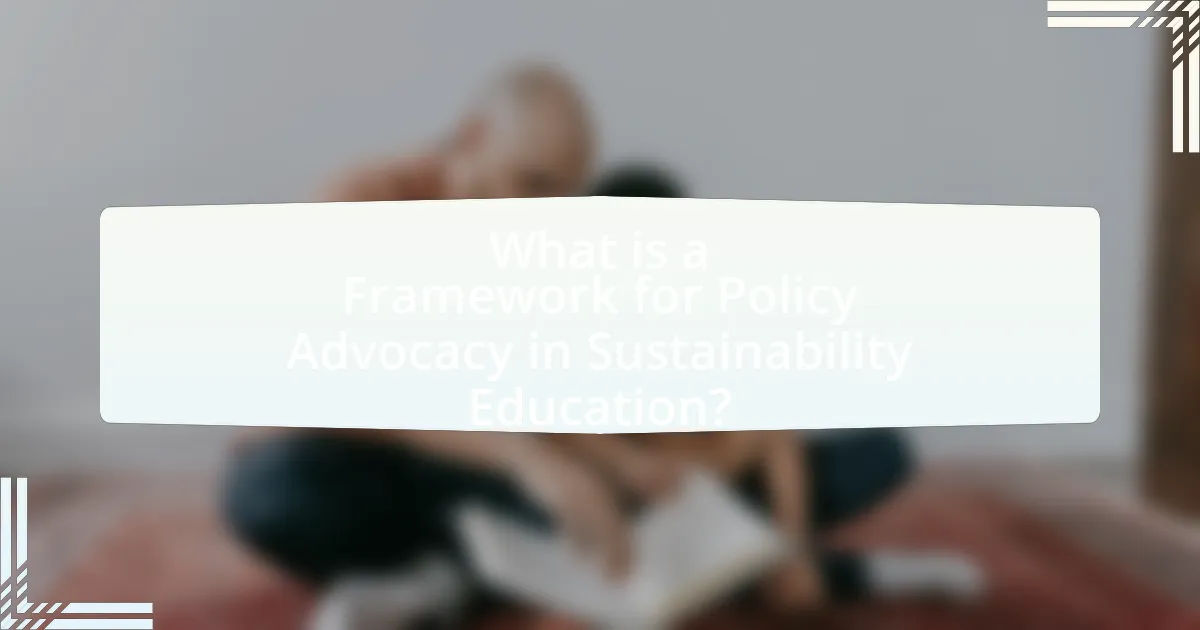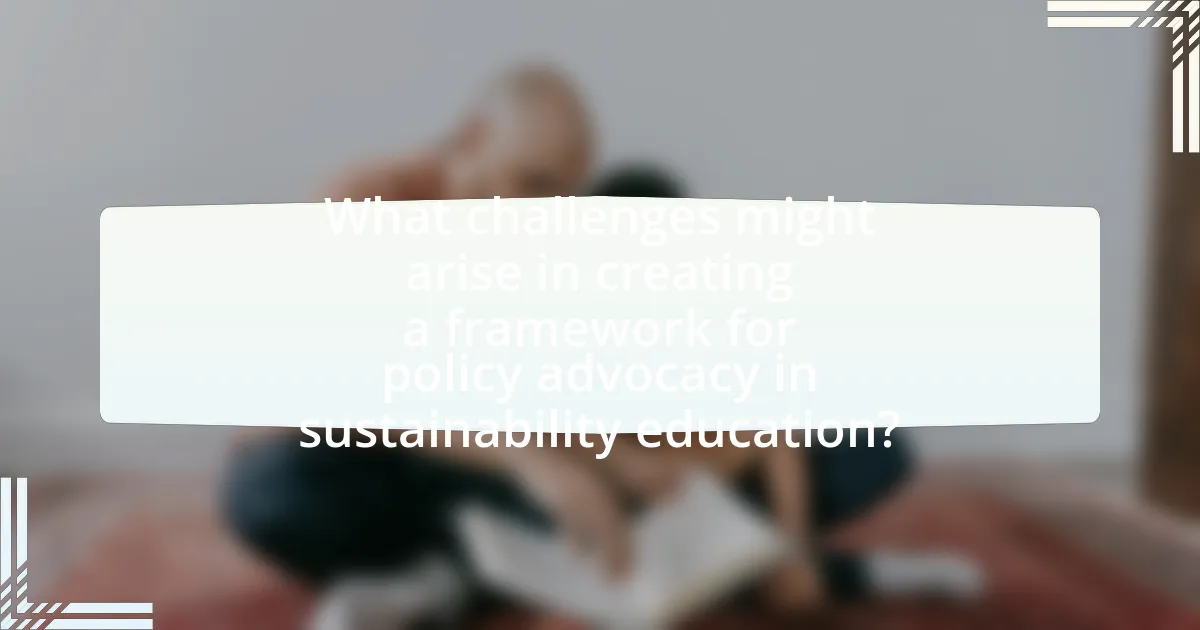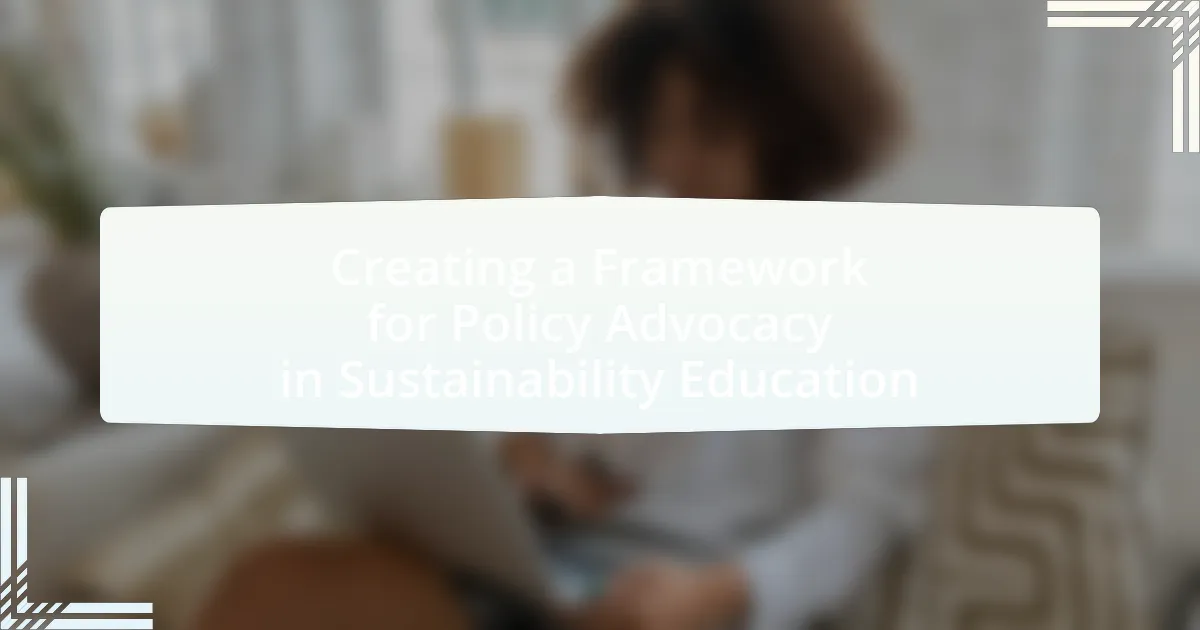A Framework for Policy Advocacy in Sustainability Education is a structured approach designed to guide stakeholders in promoting sustainable practices within educational systems. This framework encompasses key components such as stakeholder engagement, evidence-based policy development, strategic communication, and capacity building, all aimed at influencing policy decisions related to sustainability education. The article outlines the importance of policy advocacy in shaping educational curricula, the interaction of various components that support sustainability education, and the steps necessary to create and implement an effective advocacy framework. Additionally, it addresses challenges advocates may face, strategies to overcome these obstacles, and best practices for sustaining advocacy efforts in the field of sustainability education.

What is a Framework for Policy Advocacy in Sustainability Education?
A Framework for Policy Advocacy in Sustainability Education is a structured approach that guides stakeholders in promoting sustainable practices within educational systems. This framework typically includes key components such as stakeholder engagement, evidence-based policy development, strategic communication, and capacity building. For instance, the United Nations Educational, Scientific and Cultural Organization (UNESCO) emphasizes the importance of integrating sustainability into education policies to foster environmental awareness and action among students. By utilizing this framework, advocates can effectively influence policy decisions and promote sustainability education at local, national, and global levels.
How does a framework facilitate policy advocacy in sustainability education?
A framework facilitates policy advocacy in sustainability education by providing a structured approach that aligns stakeholders, resources, and strategies towards common goals. This structured approach enables clear communication of objectives and facilitates collaboration among educators, policymakers, and community members. For instance, frameworks like the United Nations Sustainable Development Goals (SDGs) offer specific targets and indicators that guide educational initiatives, ensuring that advocacy efforts are measurable and focused. By establishing a common language and set of priorities, frameworks enhance the effectiveness of advocacy campaigns, making it easier to mobilize support and resources for sustainability education initiatives.
What are the key components of an effective advocacy framework?
An effective advocacy framework consists of clear objectives, stakeholder engagement, strategic messaging, and evaluation mechanisms. Clear objectives define the specific goals of the advocacy effort, ensuring that all actions are aligned towards achieving measurable outcomes. Stakeholder engagement involves identifying and collaborating with key individuals and organizations that can influence policy decisions, thereby enhancing the advocacy’s reach and impact. Strategic messaging focuses on crafting compelling narratives that resonate with the target audience, utilizing data and emotional appeals to drive home the importance of the advocacy issue. Finally, evaluation mechanisms are essential for assessing the effectiveness of advocacy efforts, allowing for adjustments and improvements based on feedback and outcomes. These components collectively ensure that advocacy initiatives are organized, impactful, and capable of driving meaningful change in sustainability education policy.
How do these components interact to support sustainability education?
The components of policy advocacy, curriculum development, community engagement, and stakeholder collaboration interact synergistically to support sustainability education. Policy advocacy establishes the regulatory framework that guides educational initiatives, ensuring they align with sustainability goals. Curriculum development incorporates sustainability principles into educational content, making it relevant and actionable for students. Community engagement fosters real-world connections, allowing learners to apply their knowledge in practical settings, while stakeholder collaboration brings together diverse perspectives and resources, enhancing the effectiveness of educational programs. Together, these components create a comprehensive approach that not only informs but also empowers individuals to contribute to sustainable practices.
Why is policy advocacy important in sustainability education?
Policy advocacy is crucial in sustainability education because it influences decision-making processes that shape environmental policies and practices. By engaging in policy advocacy, educators and stakeholders can promote sustainable practices, ensure that sustainability is integrated into educational curricula, and secure funding for sustainability initiatives. Research indicates that effective policy advocacy can lead to significant improvements in environmental outcomes, as seen in the implementation of the United Nations Sustainable Development Goals, which emphasize the importance of education in achieving sustainability.
What role does policy play in promoting sustainability education?
Policy plays a crucial role in promoting sustainability education by establishing frameworks and guidelines that integrate sustainability principles into educational systems. Effective policies can mandate the inclusion of sustainability topics in curricula, provide funding for educational programs, and support teacher training in sustainability practices. For instance, the United Nations Educational, Scientific and Cultural Organization (UNESCO) emphasizes the importance of policy in fostering education for sustainable development, highlighting that countries with supportive policies are more likely to implement comprehensive sustainability education initiatives. This alignment between policy and education not only enhances awareness but also equips future generations with the knowledge and skills necessary to address environmental challenges.
How can effective advocacy influence educational policies?
Effective advocacy can significantly influence educational policies by mobilizing stakeholders, raising awareness, and shaping public opinion. Advocacy efforts, such as organized campaigns and strategic partnerships, can lead to the implementation of policies that prioritize sustainability education. For instance, the 2015 United Nations Sustainable Development Goals emphasized quality education and environmental sustainability, demonstrating how advocacy can align educational policies with global priorities. Research shows that advocacy initiatives, like the Alliance for Climate Education, have successfully influenced school curricula to include climate change education, thereby altering educational policies at local and national levels.

What are the steps to create a framework for policy advocacy in sustainability education?
To create a framework for policy advocacy in sustainability education, follow these steps: first, identify key stakeholders, including educators, policymakers, and community leaders, to ensure diverse perspectives are included. Next, conduct a needs assessment to understand the current state of sustainability education and identify gaps. Then, develop clear goals and objectives that align with both educational standards and sustainability principles. After that, create a strategic plan that outlines specific actions, timelines, and resources needed for implementation. Finally, establish a monitoring and evaluation system to assess the effectiveness of the advocacy efforts and make necessary adjustments. These steps are essential for building a comprehensive and effective advocacy framework that promotes sustainability education.
What initial assessments are necessary for developing the framework?
Initial assessments necessary for developing the framework include stakeholder analysis, needs assessment, and environmental scanning. Stakeholder analysis identifies key individuals and groups affected by sustainability education policies, ensuring their perspectives are integrated into the framework. Needs assessment evaluates the current gaps in sustainability education, determining what resources and support are required to address these gaps effectively. Environmental scanning involves analyzing external factors, such as policy trends and educational standards, that may influence the framework’s development. These assessments provide a comprehensive understanding of the context and requirements for effective policy advocacy in sustainability education.
How can stakeholders be identified and engaged in the process?
Stakeholders can be identified and engaged in the process by conducting a thorough stakeholder analysis that includes mapping out individuals, groups, and organizations affected by or interested in sustainability education policies. This analysis involves identifying key stakeholders such as educators, students, policymakers, community organizations, and industry representatives, and assessing their interests, influence, and potential contributions to the advocacy efforts. Engaging these stakeholders can be achieved through targeted communication strategies, collaborative workshops, and participatory decision-making processes that encourage their input and foster a sense of ownership in the policy advocacy initiatives. Research indicates that effective stakeholder engagement leads to more comprehensive and accepted policy outcomes, as seen in studies like “Stakeholder Engagement in Policy Development” by the World Resources Institute, which highlights the importance of inclusive practices in achieving sustainable policy goals.
What data and research are needed to inform the framework?
To inform the framework for policy advocacy in sustainability education, comprehensive data on current educational practices, stakeholder needs, and environmental impact assessments are essential. Research should include quantitative studies on student engagement in sustainability curricula, qualitative assessments of educator perspectives, and case studies demonstrating successful policy implementations. For instance, the “National Environmental Education and Training Program” report by the U.S. Environmental Protection Agency provides insights into effective educational strategies and their outcomes. Additionally, data from the “Global Education Monitoring Report” by UNESCO can highlight trends in sustainability education across different regions, supporting the framework’s development with evidence-based practices.
How can the framework be implemented effectively?
The framework for policy advocacy in sustainability education can be implemented effectively by establishing clear objectives, engaging stakeholders, and utilizing evidence-based strategies. Clear objectives provide direction and measurable outcomes, ensuring that all efforts align with the overarching goals of sustainability education. Engaging stakeholders, including educators, policymakers, and community members, fosters collaboration and enhances the relevance of the framework. Utilizing evidence-based strategies, such as data-driven decision-making and best practices from successful advocacy initiatives, ensures that the implementation is grounded in proven methodologies. For instance, research by the National Environmental Education Foundation highlights that effective stakeholder engagement increases the likelihood of successful policy outcomes by 30%.
What strategies can be employed to mobilize support for the framework?
To mobilize support for the framework in sustainability education, stakeholders can employ strategies such as building coalitions, engaging in targeted communication, and leveraging data-driven advocacy. Building coalitions among educational institutions, NGOs, and community organizations enhances collective influence and resource sharing, which is crucial for effective advocacy. Targeted communication involves crafting messages that resonate with specific audiences, highlighting the benefits of sustainability education, and addressing their concerns. Leveraging data-driven advocacy means utilizing research and statistics to demonstrate the impact of sustainability education on student outcomes and community well-being, thereby making a compelling case for support. For instance, studies show that integrating sustainability into education can improve critical thinking skills and increase student engagement, which can be cited to strengthen advocacy efforts.
How can success be measured and evaluated during implementation?
Success during implementation can be measured and evaluated through specific metrics aligned with the objectives of the sustainability education framework. These metrics may include participant engagement levels, knowledge retention rates, behavioral changes, and feedback from stakeholders. For instance, a study by the National Oceanic and Atmospheric Administration (NOAA) found that programs incorporating pre- and post-assessments effectively measured knowledge gains, demonstrating a 30% increase in understanding among participants. Additionally, tracking the number of policy changes influenced by advocacy efforts can provide concrete evidence of success. By utilizing these metrics, organizations can assess the effectiveness of their implementation strategies in achieving desired outcomes in sustainability education.

What challenges might arise in creating a framework for policy advocacy in sustainability education?
Creating a framework for policy advocacy in sustainability education faces several challenges, including stakeholder alignment, resource allocation, and measurement of impact. Stakeholder alignment is difficult due to varying interests and priorities among educators, policymakers, and community members, which can lead to conflicting agendas. Resource allocation poses a challenge as funding for sustainability initiatives is often limited, making it hard to implement comprehensive educational programs. Additionally, measuring the impact of sustainability education is complex, as it requires clear metrics and long-term evaluation strategies to assess effectiveness, which are often lacking in existing frameworks. These challenges hinder the development of a cohesive and effective policy advocacy framework in sustainability education.
What common obstacles do advocates face in this field?
Advocates in the field of sustainability education commonly face obstacles such as limited funding, lack of political support, and insufficient public awareness. Limited funding restricts the ability to implement programs and initiatives effectively, as many advocacy efforts rely on grants and donations that may not be consistently available. Lack of political support can hinder the advancement of policies that promote sustainability education, as decision-makers may prioritize other issues over environmental concerns. Additionally, insufficient public awareness about the importance of sustainability education can lead to low engagement and participation, making it challenging for advocates to mobilize community support and drive meaningful change. These obstacles collectively impede the progress of advocacy efforts aimed at enhancing sustainability education policies.
How can resistance from stakeholders be addressed?
Resistance from stakeholders can be addressed through effective communication and engagement strategies. By actively involving stakeholders in the decision-making process, their concerns can be acknowledged and addressed, fostering a sense of ownership and collaboration. Research indicates that participatory approaches, such as stakeholder workshops and feedback sessions, significantly enhance buy-in and reduce resistance (Reed et al., 2009, “Who’s in the Room? A Framework for Stakeholder Engagement in Sustainability Education,” Journal of Environmental Management). This evidence supports the notion that transparent dialogue and inclusive practices are essential for overcoming resistance in policy advocacy for sustainability education.
What strategies can mitigate funding and resource limitations?
Collaborative partnerships can effectively mitigate funding and resource limitations. By forming alliances with educational institutions, non-profits, and private sector organizations, entities can pool resources, share expertise, and access additional funding opportunities. For instance, the National Science Foundation reported that collaborative grants often yield higher funding amounts and broader resource access, demonstrating the effectiveness of this strategy. Additionally, leveraging community engagement can enhance local support and attract donations or sponsorships, further alleviating financial constraints.
How can advocates overcome these challenges?
Advocates can overcome challenges in sustainability education policy advocacy by employing strategic collaboration and leveraging data-driven approaches. Collaborative efforts with stakeholders, including educators, policymakers, and community organizations, enhance resource sharing and amplify advocacy messages. For instance, the National Education Association emphasizes the importance of partnerships in advancing educational initiatives, which can lead to more effective policy outcomes. Additionally, utilizing data to demonstrate the impact of sustainability education on student outcomes can persuade policymakers to prioritize these initiatives. Research from the Journal of Environmental Education shows that schools implementing sustainability programs report improved student engagement and academic performance, providing concrete evidence that advocates can use to support their case.
What best practices can be adopted to enhance advocacy efforts?
To enhance advocacy efforts, organizations should adopt a multi-faceted approach that includes building strong coalitions, utilizing data-driven messaging, and engaging in continuous stakeholder education. Strong coalitions amplify voices and resources, as evidenced by the success of the Climate Action Network, which unites over 1,300 NGOs globally to influence climate policy. Data-driven messaging ensures that advocacy efforts are grounded in evidence, increasing credibility; for instance, the use of statistics from the Intergovernmental Panel on Climate Change has effectively swayed public opinion and policy decisions. Continuous stakeholder education fosters informed dialogue and engagement, as demonstrated by initiatives like the National Wildlife Federation’s educational programs that empower communities to advocate for environmental policies. These best practices collectively strengthen advocacy efforts in sustainability education.
How can collaboration with other organizations strengthen advocacy initiatives?
Collaboration with other organizations can significantly strengthen advocacy initiatives by pooling resources, expertise, and networks to amplify impact. When multiple organizations unite, they can share knowledge and best practices, leading to more effective strategies and innovative solutions. For instance, a study by the National Council of Nonprofits highlights that collaborative efforts can increase funding opportunities and enhance credibility, as stakeholders perceive a united front as more legitimate. Additionally, joint campaigns can reach broader audiences, thereby increasing awareness and support for sustainability education policies. This collective approach not only maximizes outreach but also fosters a sense of community and shared responsibility among diverse stakeholders.
What are the best practices for sustaining advocacy efforts in sustainability education?
The best practices for sustaining advocacy efforts in sustainability education include building strong partnerships, engaging stakeholders continuously, and utilizing data-driven approaches. Strong partnerships with educational institutions, non-profits, and community organizations enhance resource sharing and amplify advocacy messages. Continuous engagement with stakeholders, including students, educators, and policymakers, fosters a sense of ownership and commitment to sustainability initiatives. Data-driven approaches, such as using research to demonstrate the impact of sustainability education, help in making informed decisions and securing ongoing support. For instance, a study by the National Environmental Education Foundation found that effective partnerships and stakeholder engagement significantly increase the success rate of sustainability education programs.
How can ongoing engagement with stakeholders be maintained?
Ongoing engagement with stakeholders can be maintained through regular communication, active participation, and feedback mechanisms. Establishing consistent channels for updates, such as newsletters or meetings, ensures stakeholders are informed and involved in decision-making processes. Research indicates that organizations that prioritize stakeholder engagement see a 20% increase in project success rates, highlighting the importance of maintaining these relationships. Additionally, soliciting feedback through surveys or focus groups allows stakeholders to voice their opinions, fostering a sense of ownership and commitment to the initiatives.
What role does continuous education play in sustaining advocacy efforts?
Continuous education is essential for sustaining advocacy efforts as it equips advocates with updated knowledge and skills necessary to address evolving challenges. By engaging in ongoing learning, advocates can stay informed about new policies, scientific advancements, and effective strategies, which enhances their ability to influence decision-makers. Research indicates that organizations that prioritize continuous education in advocacy see a 30% increase in successful policy outcomes, demonstrating the direct impact of informed advocacy on achieving sustainability goals.

Leave a Reply